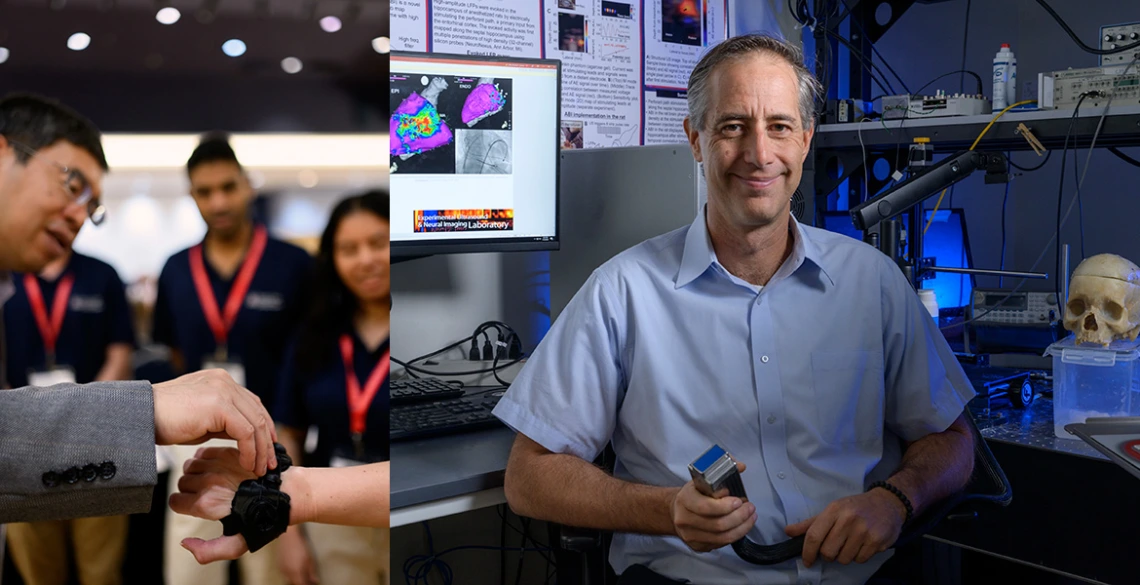Biomedical engineering faculty win grants to advance research to market
The Flinn Foundation boosts inventions that make people happier and healthier.

Zong-Ming Li (left, at the 2024 Craig M. Berge Design Day) and Russell Witte (in the Experimental Ultrasound and Neural Imaging Lab) each won $100,000 from the Flinn Foundation to move health care products closer to market. Both are affiliated with the Department of Biomedical Engineering.
Zong-Ming Li designed an effective, noninvasive therapy for carpal tunnel syndrome. His wearable device applies local force to treat nerve compression within the wrist, thus relieving symptoms including hand and arm pain, weakness, numbness and tingling.
Russell Witte created an imaging system to rapidly map electrical signals in the brain with resolution and accuracy far exceeding standard methods like electroencephalography and functional magnetic resonance imaging.
The Flinn Foundation selected Li and Witte to receive $100,000 grants through its 2025 seed grants program. Witte’s award is a follow-on; he first received the Flinn award in 2023 and was granted an additional $100,000 to progress his solution.
Li: relief for CTS
Li, a professor of biomedical engineering and orthopedic surgery, published his first paper on treating CTS symptoms with precise applications of force in 2009 in the Journal of Mechanical Engineering.
“Looking back, that was a landmark paper,” he said.
The American Society of Mechanical Engineers honored Li with its Savio L-Y. Woo Translational Biomechanics Medal for his findings. Since that time, Li has conducted research – including clinical trials – to refine the approach and optimize a patient-friendly and cost-effective design for the carpal arch space augmentation, or CASA, device. He is working with an Interdisciplinary Capstone team of engineering students on an updated prototype variation, having sponsored two teams during the last academic year.
Li has also been working with Tech Launch Arizona, the university’s commercialization arm, to patent and commercialize the invention. He hopes to join forces with an entrepreneur to launch a company that will offer CASA as a product patients can buy for $200 or less.
The Flinn seed grant supports further research to refine the design, said Li. Once the design is perfected and approved by the Food and Drug Administration, and a company takes on its manufacturing and distribution, Li will realize his long-held goal to bring relief to the 1% to 5% of American adults affected by CTS, as estimated by the National Institutes of Health.
“Our data shows the promise,” said Li, also the William and Sylvia Rubin Chair of Orthopedic Research. “I’m determined that now we have to move forward and bring this to the patient.”
Witte: better brain imaging
Witte, a professor of biomedical engineering with a primary appointment in medical imaging, has pioneered the development of transcranial acoustic electric brain imaging, or tABI. The technique maps deep brain stimulation, or DBS, currents through the skull. tABI works with DBS to improve neurosurgery, personalize electrical stimulation therapies for neurological disorders, and monitor patients’ long-term health.
Witte’s initial Flinn seed grant supported the development of a custom, noninvasive ultrasound probe for imaging through the temporal window, the thinnest part of the human skull, located at the temples. This allows for high-quality imaging of deep brain structures and stimulation currents.
The follow-on grant will fund optimization of tABI performance, including a feasibility study. And the foundation’s support extends beyond the grant, said Witte, whose joint professorships include the university’s BIO5 Institute and the Wyant College of Optical Sciences.
“The Flinn Foundation’s quarterly meetings promote interaction with other teams and offer instruction and networking opportunities with industry experts,” he said, adding that the Flinn Foundation also hosts regional conferences and related events.
Witte, too, is working with TLA to protect the invention and identify a business partner to help bring it to the marketplace. He expects to begin testing on human subjects within the next year. Once he secures initial investment, Witte believes it will take two more years to produce a tABI system medical providers can use to map electrical currents in the human brain.
“I envision this disruptive modality to not only improve DBS treatment for Parkinson’s disease but also provide unique clinical value for epilepsy patients who depend on accurate electrical brain maps for both diagnosis and guiding treatment decisions,” said Witte.



